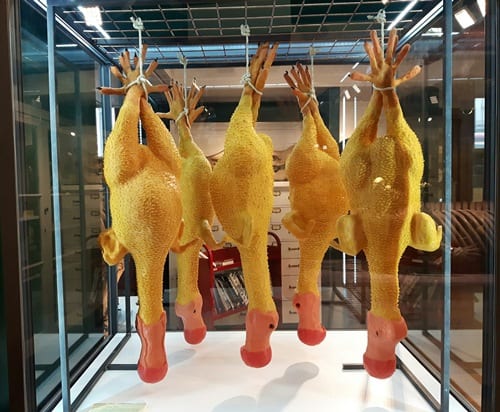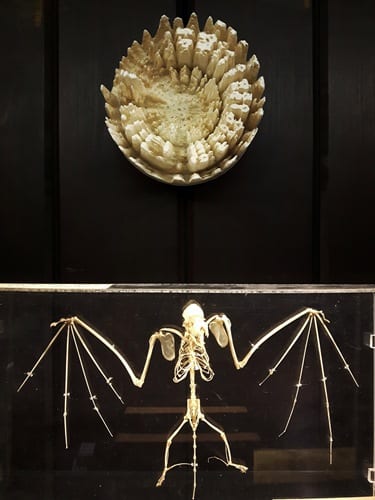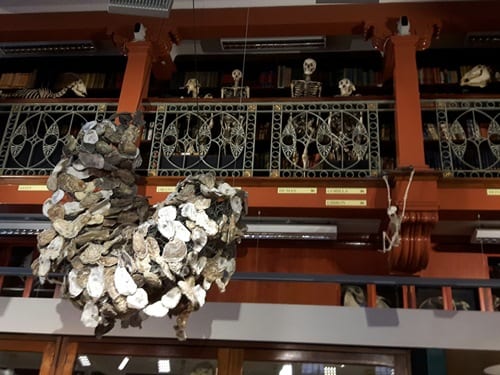Skullpture at the Grant Museum opens today
By Jack Ashby, on 26 May 2016
For our newest exhibition – Skullpture at the Grant Museum – twelve sculpture students from UCL’s Slade School of Fine Art have been invited to develop works in response to the Museum’s collections, science and history.
The new artworks – which relate to death and decay, extinction, cloning, and animal behaviour – have been placed among the Museum’s own skeletons, skulls and specimens preserved in fluid. The exhibition engages with animal and human encounters and transforms the historic zoological museum in ways that will leave visitors questioning whether some of the installations are playful or serious.

Dead as a Dodo © Will Spratley. A collection of rubber-chicken like dodo models, strung up as if in a butcher’s window.
In one work by Will Spratley, a collection of life-size models of dodo carcasses has been strung up as if plucked and hung in a butcher’s window. The comical-looking dodo has long been an icon of historic extinction – but will placing it in this modern context make people think differently about it?
Some of the other works link closely to scientific concepts linked to our collections, but featured through the lens of the artists’ interpretation.
Alex Leigh was inspired to our preserved marsupial collection, particularly the thylacine specimen which was once sampled to see if sufficient genetic material survived to possibly clone it. He has created silicon “clones” of preserved infant thylacines – which look extremely similar to many of our real marsupial infants – and set up an audio dialogue between them, arguing over who is the genuine claimant of their shared identity.Jake Elwes responded to spectrograms of animal calls that zoologists use to study animal behaviour and also the origins of language. He created a program which analyses the frequencies in the vocalisations and then spins them into 3D forms, which have been 3D printed into sculpture. The visualised calls are displayed alongside specimens of the species which made them.
These are just a couple of examples from a really diverse range of interventions, that will make exploring the museum even more surprising than it already is.
What’s really exciting for me, as someone who manages a museum dedicated to finding interesting ways to relate people to the natural world, is that this group of twelve artists have found ways of engaging visitors with real scientific issues in ways that most scientists would never imagine.
It’s been an occasionally nerve-wracking process – allowing the Museum to be taken over by sculpture students for a couple of months is inherently risky (particularly the bit where we suspended a huge mass of oyster shells in the air over the centre of the museum*). But without doubt it’s been overwhelmingly exciting and has allowed the entire museum team to see our collection differently.
Skullpture at the Grant Museum runs until 6th August 2016. Admission is free.
* This was only made possible because we have some fantastic skills in our department – UCL Museums is part of UCL Public and Cultural Engagement, which also includes the Bloomsbury Theatre, and we are very grateful to Jo Howcroft, the theatre technician, who expertly rigged up the oyster sculpture.
Jack Ashby is Manager of the Grant Museum of Zoology
One Response to “Skullpture at the Grant Museum opens today”
- 1
 Close
Close


![You want to be in my [dopple]gang, my [dopple]gang, my [dopple]gang? (C) Alex Leigh](https://blogs.ucl.ac.uk/museums/files/2016/05/20160525_155043_resized.jpg)


[…] in 2016: our two exhibitions were based on artistic ways of looking at scientific topics. First was Skullpture, when we invited the Sculpture students from the Slade School of Fine Art to takeover the museum […]